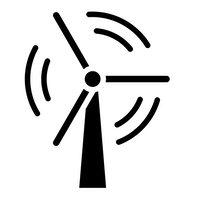Wind turbine recycling: answering your questions
Re-Rewind is a first-of-its-kind project, so we understand that information is limited and you have questions that need to be answered.

Re-Rewind is a first-of-its-kind project, so we understand that information is limited and you have questions that need to be answered.

Doesn’t the upfront carbon cost of manufacturing turbines negate the environmental benefits of wind energy?
Most wind turbines “pay back” the carbon impact of their production within their first year of operation and go on to provide decades of clean energy.

What materials can be found in a wind turbine?
From high-quality construction steel, copper and other metals to a range of rare earth elements (such as praseodymium and dysprosium), modern wind turbines contain a wealth of materials which, if they cannot be sourced from recycled channels, must be mined, leading to increased environmental impacts and resource scarcity.
In particular, the wind turbine sector uses very large quantities of a rare earth magnet that’s an alloy of neodymium, iron and boron (NdFeB). These NdFeB magnets are critical components used in PMSGs (Permanent Magnet Synchronous Generator) in larger onshore and offshore wind turbines.

How much of a wind turbine can already be recycled?
The first generation of wind turbines are now reaching the end of their operational lives and are proving to be a rich source of high-quality, low carbon recyclable material.
Around 85% of a wind turbine is made from steel which is easy to recycle and can be melted down and reused infinitely.
Beyond this, copper, aluminium and even concrete can – and are – being recycled as these turbines are being decommissioned.
Re-Rewind is looking to extend these positive outcomes by ensuring the rare earth metals within every turbine can also be recovered and recycled.

What about refurbishment?
At its workshop on the coast of Argyll & Bute, Scottish SME Renewable Parts employs local people to refurbish valuable components from end-of-life wind turbines, and supplies them back to the industry in place of those made from virgin metals.
This process is even less energy-intensive than recycling and, at EMR, we always explore every option for a sustainable solution.

What are the other future opportunities?
It is true to say that recycling turbine blades – which represent about 10% of the weight of a whole turbine – isn’t a simple task, but it is a challenge that engineers, entrepreneurs and recyclers are tackling around the world.
For example, Scottish-based company Re-Blade is using these blades – made from a combination of balsa wood and fiberglass – to build furniture and bike shelters.
On a global scale, major wind turbine owners, blade manufacturers, and recycling companies such as EMR, are all investing huge sums of money into developing industrial scale recycling solutions for blades. This technology is still in its infancy and larger scale recycling options will undoubtedly soon emerge.
If you have any questions about recycling wind turbines that we haven’t answered here, please get in touch.